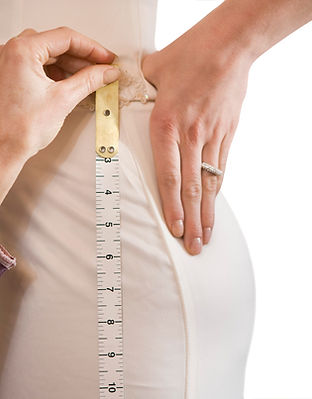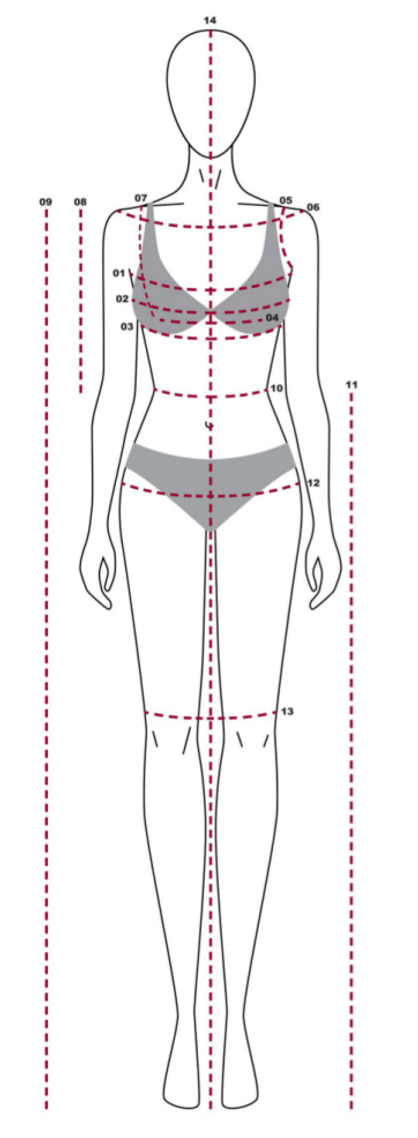
MEASUREMENTS
HOW TO MEASURE
At Lua Tailor, we make it easy to get perfectly tailored clothing. With our custom measurements, you can be sure that your clothing will fit you perfectly. Getting the most accurate measurements is important, as it makes the process go smoothly and ensures your clothing is exactly what you want. Our tailors are experts at their craft, and they will work with you to make sure your clothing is perfect. Contact us today to schedule a fitting in store, or follow these basic steps for ordering online.

TUTORIAL
Accurate measurements are essential for well-fitted and comfortable clothes. Following simple steps can help avoid common measurement mistakes and ensure precise measurements for a perfect fit. All you'll need is a fabric measuring tape, it also helps to ask a family member or friend to help you!
1. Upper Bust
Begin by wrapping a tape measure around your upper bust area, directly beneath your armpits and over the top of your bust. Ensure that the tape measure forms a loop that is mostly parallel to the floor. However, it's okay if it angles up slightly at the front to clear the top of your bust.
2. Bust
Place the tape around the mid points of your bust, make sure to fit at least one finger between the tape and your bust
3. Lower Bust
Wrap measuring tape tightly around your underbust
4. Apex to Apex
Measure the distance between highest point of the curve of each breast
5. Arm loop (bicep)
To measure your bicep accurately, wrap the tape around the fullest part of your upper arm, keeping your arm down and relaxed.
6. Shoulder to Shoulder
When measuring shoulder to shoulder, take the tape from one end of the shoulder to the other, across the back. Be sure to follow the natural curve of the body, rather than pulling a straight line between the two points. This measurement should be similar to the length between the shoulder seams of a suit jacket.
7. Shoulder to Bust
To measure the distance from the top of your shoulder to the center of your nipple, begin by placing the end of a measuring tape at the midpoint of your shoulder's top end.
8. Shoulder to Waist
Measure vertically from the midpoint on top of your shoulder down to the front of your body, until you reach the point level with your belly button.
9. Shoulder to floor
Stand up straight and measure the distance from the floor to the top of your shoulder, ensuring that the measuring tape runs over your bust and forms a straight, vertical line.
10. Waist
Take a deep breath out, then slide the measuring tape halfway between your hip bone and rib cage, in line with your belly button. Make sure it's snug but not tight; you should be able to slide a finger in between the tape and your skin
11. Waist to floor
Locate the highest point of your waist and use a measuring tape to determine the distance between it and the floor. When measuring, taking the measurement from the side of your body is often the simplest method.
12. Hips
Wrap the tape measure all the way around the highest hip point (booty), allow the tape measure to move freely up and down the hip.
13. Upper Knee Width
To measure the circumference of your knees, use a soft tape measure or a string and measure directly underneath the kneecaps. Stand in a weight-bearing position with your legs fully straight to obtain the most accurate measurement.
14. Full Height
To determine your height, place a ruler, book, or any flat object on your head and make a light pencil mark on the wall where it meets. Then, use a tape measure to measure the distance from the floor to the mark on the wall. For best results, use a metal tape measure that will not bend or curve.
Use this numbered diagram as a guide

CONGRATULATIONS!
By following these steps correctly, you are well on your way to achieving that perfectly fitted new garment.Simply head over to the 'get a quote' page, provide us with your measurements and garment specifications, and we'll get in touch with you as soon as possible.
